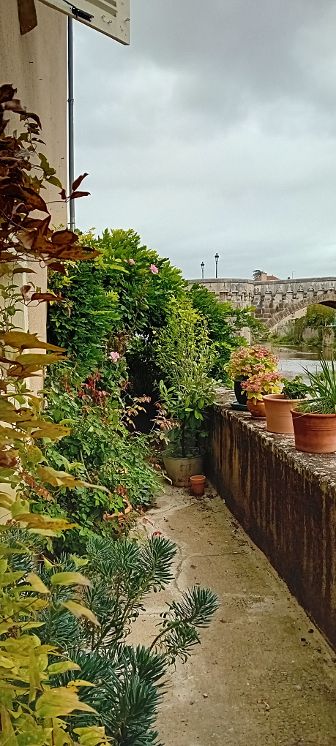.
This picture was taken in 1906; it is interesting in many ways; the history of the relations between women and men; the history of architecture; the history of the town of Montmorillon – for instance, my house, here next to the washing place, the one with the balcony, attached to the rounded left-over of a former defence tower. Of the line of houses on the photo, mine is the only one still standing; the others, from my balcony up to the Gothic bridge, have all been demolished.
What is of interest, is also the presence of the Wisteria on the balcony of the house which was bought in 2020; its time-perspective. This is how I found the river terrace, four years ago:
.
.
It had been completely overgrown with the plant, its main root coming from the balcony floor, already thick as a tree’s trunk; so badly overgrown it was, that two of the three doors leading from the cellars onto the terrace could not be opened; I had to climb over and through the bush, in order to get to the source of its outgrowth. That it could have overstretched its empire, was due to the fact that the house, for twelve long years, had been unoccupied. Literally working on it for days on end, with both the standard and the electric saw, it finally looked like this:
.
.
By that time, because of the chunks and trunks of stone-hard wood which had dropped into in it, the river below the balcony must have swollen centimetres. They talk of oak wood as hard. Makes me laugh; after the job had been completed, oak wood compares to the stuff the Wisteria is made of, as fresh cake to bread toasted thrice over. This must be the reason that everything points to my Wisteria as the self-same Wisteria which is seen in the 1906-picture; same entry of the roots, same trailing of its branches.
One may also observe the heavenly Belvedere, added to the house, on top of the rest-bottom of the round tower-rest on its left. It is from there, that I daily espy the large meander which leads the river to my house, contemplating its wild ups and gentle downs, with its variety of birds and skies; as well as, when in bloom, the Wisteria’s mysteriously blue flowers.
.
.
From all this, we may deduce what kind of Wisteria it is. The ‘Wisteria floribunda’, the Japanese version, has a life span of at most fifty years; this one must be its Chinese sister – the ‘Wisteria sinensis’, which may survive up to one hundred and fifty years, twice the normal age of the human species. Yet, one may also give this tale a moribund twist. As in the 1906-picture of house, the plant seems to be already in full standing, it must now be at least one hundred and twenty-five years of age; a mere twenty-five years to go…
Yet, taking the state of my bodily frame, it will certainly outlive me; this tree of life, planted in my little paradise, will give the joy of its beauty, as well as produce the anxiety that the roots will continue to undermine both the balcony, and the walls of the house. With the deceptively airy flowers, the Wisteria is known to be wistful and cruel to buildings at the same time.
.
.
Sierksma, Montmorillon 22.1.2024




